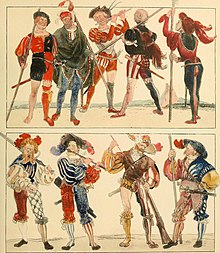Landsknecht
Consisting predominantly of pikemen and supporting foot soldiers, their front line was formed by Doppelsöldner ("double-pay men") renowned for their use of Zweihänder and arquebus.Although prone to mutiny if unpaid and divided within their ranks between Catholics and Lutherans, the Landsknechte were well-armed and experienced warriors, recruitable in large numbers throughout Germany and Austria by the Holy Roman Emperor.At their peak during the reign of Charles V of Habsburg, and under the leadership of notable captains such as Georg von Frundsberg and Nicholas of Salm, the Imperial Landsknechts obtained important successes such as the capture of the French King Francis I at the Battle of Pavia in 1525 and the resistance against the Ottoman Turks led by Suleiman the Magnificent at the Siege of Vienna in 1529, while also being responsible for the Sack of Rome in 1527.The Swiss pikemen, called Reisläufer, repeatedly defeated and eventually killed Charles, eliminating Burgundy as a European power.[9] The dissolution of his levied army at war's end found Maximilian wanting a permanent and organized military force like the Confederation's to protect his domain.One of these units he gave to Eitel Friedrich II, Count of Hohenzollern, who trained them with Swiss instructors in Bruges in 1487 to become the "Black Guard"[a] – the first Landsknechte.The Landsknechte in his army refused to serve after sacking Stuhlweissenburg (now Székesfehérvár, Hungary), citing lack of pay and stopping Maximilian's advance on Buda.Paul Dolnstein [de] wrote of the siege of Älvsborg Fortress in July 1502, fighting for the king of Denmark: "We were 1800 Germans, and we were attacked by 15000 Swedish farmers ... we struck most of them dead.They also served in high numbers in the Imperial army during the campaigns of Austria (1532), France (1542), Germanic Reformed League (1547) and in of all the Italian wars.In the army of the Dutch rebels, many German mercenaries were hired but were forced to give up some Landsknecht traditions in order to increase their discipline in river crossing and their naval fighting abilities.Increasing ill-discipline within the ranks saw them replaced with an improved system of raising a German army, the Kaiserlicher Fussknecht, which was far less reliant on mercenaries.Thus, the role of the regiment, leadership by example (commanders tended to dismount to fight with the troops) and harsh discipline (involving capital punishment) were emphasized to compensate.Rotten, equivalent to a platoon, were the building blocks of the Fähnlein and contained either ten ordinary Landsknechte or six Doppelsöldner, led by a Rottmeister elected by his unit.[24] Included in that staff were a chaplain, a scribe, a doctor, a scout, his personal quartermaster and ensign, a drummer and fifer, and a bodyguard (Trabanten) of eight men.[28] Experienced and well-equipped soldiers, receiving double a normal Landsknecht's pay and getting the title Doppelsöldner,[29] made up a quarter of each Fähnlein.[39][40] The Tross were the camp followers or baggage train who travelled with each Landsknecht unit, carrying military necessities, the food, and the belongings of each soldier and his family.








LansquenetetchingDaniel Hopferpike and shotearly modern periodpikemenDoppelsöldnerZweihänderarquebusHoly Roman Empire'sImperial ArmyHabsburg-Valois warsHabsburg-Ottoman warsEuropean wars of religionCatholicsLutheransHoly Roman EmperorCharles V of HabsburgGeorg von FrundsbergNicholas of SalmFrancis IBattle of PaviaSuleiman the MagnificentSiege of ViennaSack of RomeFugen-"s"court ushersGerman languageCharlesDuke of BurgundyMaximilian IBurgundian WarsCharles the BoldSwiss Confederationesprit de corpsSwiss pikemenMaximilianMary of BurgundyBattle of Guinegatewagon fortsEitel Friedrich II, Count of HohenzollernBrugesBlack GuardSwabian LeagueBavariaBohemiaStuhlweissenburgHungaryÄlvsborg FortressBattle of NovaraBattle of BicoccaBattle of MarignanoarquebusesBernard van Orleypeasants' revoltthe Habsburg emperorthe royal Valencian authoritiesthe mountains of Espadàmodern-day Spanish Castelló provinceAragoneseKingdom of ValenciaValencianMuslimfellahsReisläuferpush of pikeHans Holbein the YoungerJohn III of NavarreHenry II of Navarrecampaigns to reconquer NavarreHondarribiaGermanic Reformed LeagueHabsburg-Ottoman frontierarmy of the Holy Roman EmperorCharles III, Duke of BourbonCharles VFrench Wars of ReligionEighty Years WarterciosErnst FriedrichBaden-Durlachgreavesregimentletter patentcolonelArticles of WarcaptainsdrummersmusterEmperorFähnricheensignslieutenant colonelFähnleincompanyplatoonsergeant majorsFeldweibelscribeTrabantenprovost marshalSchultheissmutinyhalberdstwo-handed swordarquebusierscrossbowmenKatzbalgerpike squareforlorn hopehalberdiersJean MolinetPeter HagendorfBurgmannFeldhauptmannFree companyFreikorpsTrabant (military)HeerhaufenKabukimonosamuraiNorth SeaBattle of HemmingstedtThomas Dunne BooksRogers, CliffEncyclopedia Britannica